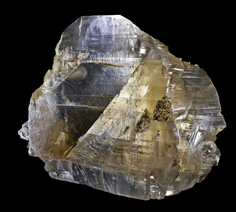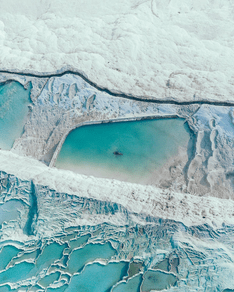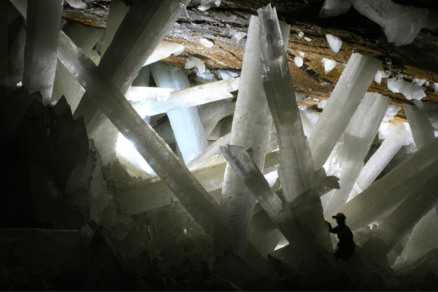Gypsum: Isotopes & Dating
 Gypsum is a relatively soft and common mineral made up of hydrous calcium sulfate (CaSO4-2H2O). Whilst pure gypsum crystals are transparent (often with a pearly or vitreous luster), they can appear opaque and colored due to the inclusion of other materials (e.g. sand).
Gypsum is a relatively soft and common mineral made up of hydrous calcium sulfate (CaSO4-2H2O). Whilst pure gypsum crystals are transparent (often with a pearly or vitreous luster), they can appear opaque and colored due to the inclusion of other materials (e.g. sand).
It often forms in evaporative sedimentary environments and is commonly found intact floating within other carbonate and/or evaporite minerals. Within evaporative environments of high salinity, typically organic material (which is commonly dated) is scarce – thus, gypsum can provide a vital alternative. One well known example of such occurrences is the intact gypsum crystals found within the sedimentary layers of Great Salt Lake in Utah (bottom left) – sometimes described as “dirty diamonds”.
In other cases, gypsum is found in areas where groundwater interacts with sediments including within cave systems and hot springs. An example of such a formation is the Cave of Crystals in Mexico (below right), which contains giant gypsum crystals up to 37 feet tall. Whilst speleothems (cave mineral deposit) are most commonly formed of calcium carbonate, they are less commonly formed of gypsum. These samples can be particularly useful as an archive for paleoclimatic studies (Gázquez et al. 2020).
Throughout human history, gypsum has had many uses including within ancient artwork (Mishmastnehi et al. 2023), plaster (i.e. Plaster of Paris; Keane, 2002) and even as a method of body casting and preservation (creating a hard coating) in Roman times (Brettell et al. 2018). In modern times, it’s more commonly used as a constituent of chalk and drywall.


Dating of gypsum
Dissolved uranium can find its way into the gypsum crystal during the crystallization which provides the potential to be dated using the Uranium-Thorium (U-Th) method. However, gypsum tends to have low uranium content, can be prone to inclusions and may undergo post-depositional alteration, challenging dating using this method (Gázquez et al. 2022; Sanna et al. 2010). Hence, the purification and preparation of samples prior to dating is extremely important. Isobar Science offers dating of gypsum crystals using the U-Th technique. Gypsum samples submitted for U-Th dating must be a minimum of 1000mg, free of organics and detrital carbonates and should be packaged either in glass or plastic vials.
Boron & Strontium Isotopes
Given the fact that gypsum can be found in sedimentary strata and cave deposits, the isotopic signature can be very useful for paleoclimatology studies. Depending on the environment where the gypsum was found, boron can be a useful tool to reconstruct variations in oceanic or lacustrine pH and CO2 concentrations (Ma et al. 2017) whilst strontium can be applied to investigate the strontium cycle (87Sr/86Sr variability) driven by various geological processes (Kirichenko et al. 2023) including weathering.
Learn more about U-Th dating, Strontium Isotopes and Boron Isotopes at Isobar Science
Contact us today to discuss your research project!
References
Brettell, R., Schotsmans, E.M., Martin, W., Stern, B. and Heron, C.P., 2018. The final masquerade: resinous substances and Roman mortuary rites. The bioarchaeology of ritual and religion, pp.44-57.
Gázquez, F., Bauska, T.K., Comas-Bru, L., Ghaleb, B., Calaforra, J.M. and Hodell, D.A., 2020. The potential of gypsum speleothems for paleoclimatology: Application to the Iberian Roman Humid Period. Scientific reports, 10(1), p.14705.
Gázquez, F., Monteserín, A., Obert, C., Münker, C., Fernández-Cortés, Á. and Calaforra, J.M., 2022. The Absolute Age and Origin of the Giant Gypsum Geode of Pulpí (Almería, SE Spain). Geosciences, 12(4), p.144.
Keane, L.A., 2002. Plaster of Paris. The Journal of Physical Chemistry, 20(8), pp.701-723.
Kirichenko, Y., Rickli, J.D., Bontognali, T.R. and Shalev, N., 2023. New insights into the Sr isotope budget from stable-Sr isotope fractionation in gypsum (No. EGU23-12512). Copernicus Meetings.
Ma, Y.Q., Peng, Z.K., Yang, J., Xiao, Y.K. and Zhang, Y.L., 2017. Determination of boron content and isotopic composition in gypsum by inductively coupled plasma optical emission spectroscopy and positive thermal ionization mass spectrometry using phase transformation. Talanta, 175, pp.250-255.
Mishmastnehi, M., Van Driessche, A.E., Smales, G.J., Moya, A. and Stawski, T.M., 2023. Advanced materials engineering in historical gypsum plaster formulations. Proceedings of the National Academy of Sciences, 120(7), p.e2208836120.
Sanna, L., Saez, F., Simonsen, S., Constantin, S., Calaforra, J.M., Forti, P. and Lauritzen, S.E., 2010. Uranium-series dating of gypsum speleothems: methodology and examples. International Journal of Speleology, 39(1), p.5.
